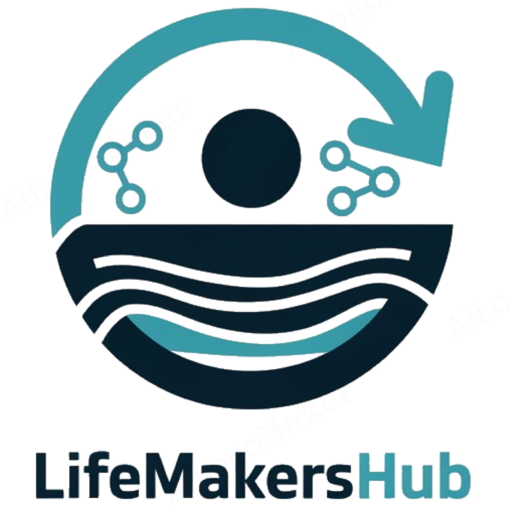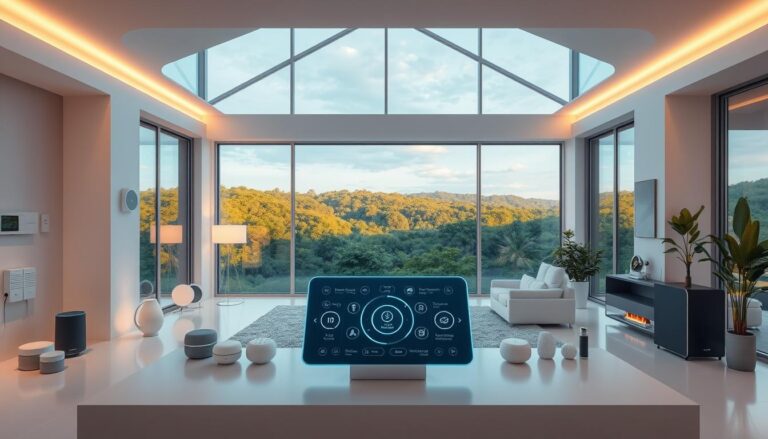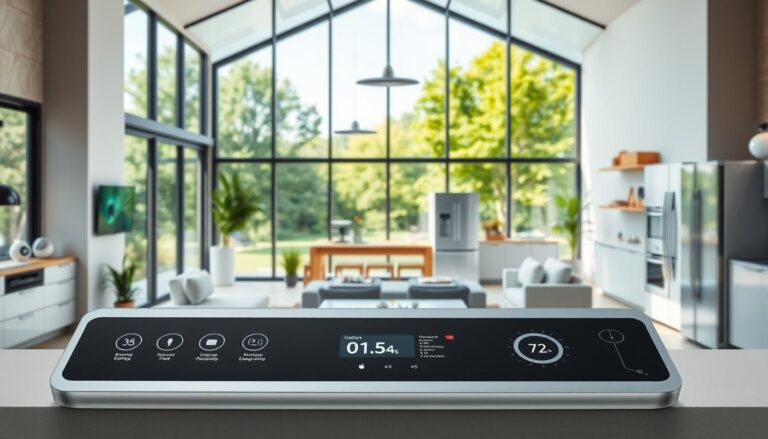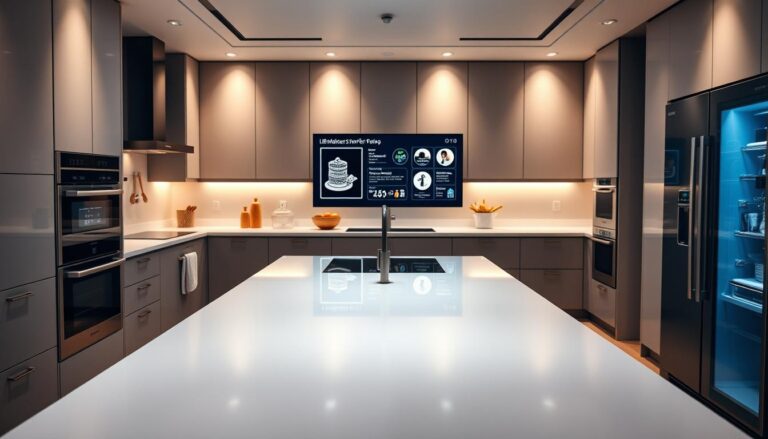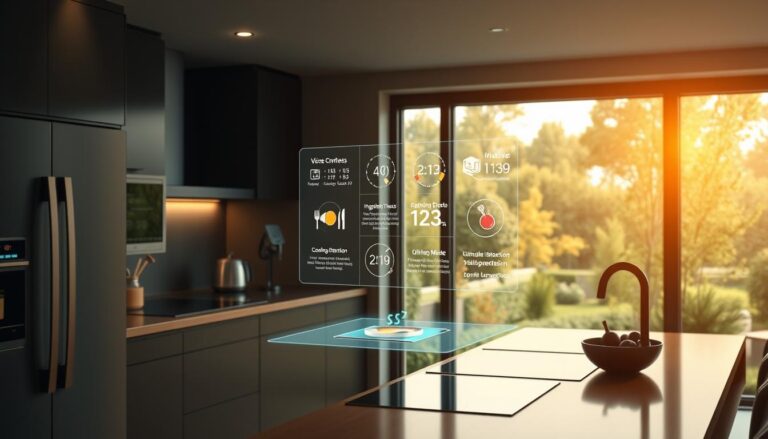Boost Your Home’s Energy Efficiency
Making your home more efficient isn’t just about saving money—it’s about creating a better living environment. By focusing on energy efficiency, you can reduce your energy consumption while contributing to a healthier planet. Simple changes, like improving insulation or upgrading appliances, can make a big difference.
Did you know that proper insulation can save up to 20% on heating and cooling costs? Smart home technology, like programmable thermostats, can also help you manage usage more effectively. These upgrades not only lower utility bills but also enhance comfort year-round.
An energy audit is a great starting point. It identifies areas where your home can improve, from sealing drafts to optimizing lighting. With the right adjustments, you’ll see immediate benefits—both financially and environmentally.
Key Takeaways
- Improving insulation can save up to 20% on heating and cooling costs.
- Smart home technology helps manage energy use more effectively.
- An energy audit identifies key areas for improvement.
- Upgrading appliances reduces utility bills and enhances comfort.
- Small changes can lead to significant environmental benefits.
Understanding Energy Efficiency Fundamentals
To make smarter choices, it’s essential to grasp the fundamentals of energy management. Efficient practices not only save money but also contribute to a healthier environment. Let’s break down the key concepts to help you get started.
Defining Energy Efficiency
Energy efficiency means using less power to achieve the same results. For example, LED bulbs provide the same brightness as traditional ones but use significantly less electricity. This approach focuses on optimizing use without sacrificing performance.
Energy Efficiency vs. Energy Conservation
While both aim to reduce consumption, they differ in approach. Efficiency focuses on smarter use, like upgrading to a high-performance HVAC system. Conservation involves reducing usage, such as turning off lights when not needed. Both are crucial for lowering gas and electricity bills.
Tracking your consumption is vital. Tools like smart meters help identify waste and highlight areas for improvement. For instance, optimizing thermostat settings can save up to 15% on heating and cooling costs.
Industry standards like ENERGY STAR provide benchmarks for efficient products. Appliances with this certification use less power without compromising functionality. Real-world examples include smart lighting systems that adjust based on occupancy, reducing unnecessary use.
By understanding these fundamentals, you can make informed decisions that benefit both your wallet and the planet.
Key Benefits: Savings, Comfort, and Environmental Impact
Investing in smarter home solutions offers more than just comfort—it’s a step toward a sustainable future. By focusing on better building practices and upgrading appliances, you can enjoy significant cost savings while reducing your environmental footprint.
Cost Savings and Lower Utility Bills
One of the most immediate benefits is the reduction in utility bills. Upgrading to energy-efficient appliances can save homeowners between 5 to 30 percent on monthly expenses. For example, an ENERGY STAR certified heat pump water heater uses 70% less power compared to standard models, saving a family of four over $550 annually.
Small changes, like improving insulation or switching to LED lighting, also add up. These upgrades not only lower costs but also enhance the overall performance of your building.
Reducing Greenhouse Gas Emissions
Another critical benefit is the reduction of greenhouse gas emissions. Homes account for nearly 20% of national emissions, but simple measures can cut this by 25 to 30 percent. Efficient building designs and modern appliances play a significant role in achieving this.
For instance, ENERGY STAR certified buildings use 35% less power than typical structures. This not only lowers emissions but also improves air quality, creating a healthier living environment.
By making these changes, you’re not just saving money—you’re contributing to a cleaner, greener planet.
Technology Innovations in Energy Consumption Reduction
Technology is reshaping how we manage power in our homes, offering smarter ways to reduce consumption. From smart thermostats to advanced appliances, these innovations are making it easier to cut back on fuel and oil use while boosting savings.
Smart Thermostats and Home Automation
Smart thermostats, like the Nest Learning Thermostat, are game-changers. They learn your schedule and adjust heating and cooling automatically. This can save up to 10% on bills by optimizing usage.
Home automation systems take it further. They integrate lighting, appliances, and climate control into one platform. For example, lights turn off when you leave a room, and your HVAC system adjusts based on occupancy.
Energy-Saving Appliances
Modern appliances are designed to use less power without sacrificing performance. ENERGY STAR certified models, like refrigerators and washing machines, consume significantly less fuel and electricity.
Take heat pump water heaters, for instance. They use 70% less power than traditional models, saving families hundreds annually. These advancements set new standards for household savings and sustainability.
“Smart technology isn’t just convenient—it’s a practical way to reduce reliance on oil and other traditional fuels.”
By embracing these innovations, you can enjoy lower bills, enhanced comfort, and a smaller environmental footprint. The future of home management is here, and it’s smarter than ever.
Maximizing Energy Efficiency in Your Home
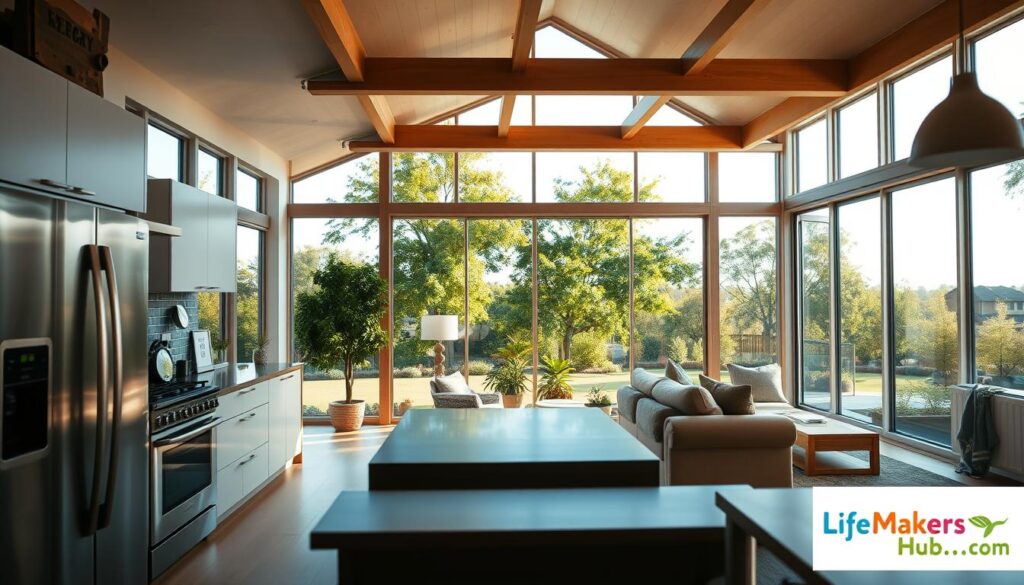
Transforming your home into a more sustainable space starts with simple, effective upgrades. By focusing on practical improvements, you can reduce your environmental impact while enhancing comfort and savings.
Efficient Lighting Solutions
One of the easiest ways to cut down on heat and power use is by upgrading to LED lighting. These bulbs use up to 75% less power than traditional incandescent ones and last significantly longer. For the consumer, this means lower bills and fewer replacements.
LEDs also produce less heat, reducing the strain on your cooling systems during warmer months. This dual benefit makes them a smart choice for any home.
Effective Insulation and Window Upgrades
Proper insulation is key to maintaining a consistent indoor temperature. It prevents heat loss in winter and keeps your home cooler in summer. Modern materials like spray foam or cellulose offer superior performance compared to older options.
Upgrading windows to double or triple-pane models can also make a big difference. These windows reduce drafts and improve insulation, helping you save on heating and cooling costs.
“Investing in better insulation and windows is one of the most effective ways to reduce emission and enhance comfort.”
By implementing these changes, you’ll not only save money but also contribute to a healthier planet. Start with small steps, and you’ll see the benefits in no time.
Energy Efficiency in Appliances and Equipment
Choosing the right appliances can transform how you manage household costs and environmental impact. By opting for ENERGY STAR certified products, you can significantly reduce the amount of power needed for daily tasks. These appliances are designed to perform better while using less resources, making them a smart choice for any home.
Selecting ENERGY STAR Certified Products
One of the easiest ways to cut down on costs is by upgrading to ENERGY STAR certified appliances. These products meet strict guidelines set by the U.S. Environmental Protection Agency, ensuring they use less power without compromising performance. For example, an ENERGY STAR refrigerator can save up to $400 over its lifetime compared to standard models.
These appliances also help reduce gas emissions and greenhouse impacts. By using less electricity, they contribute to a cleaner environment. A single ENERGY STAR certified washer can prevent over 1,000 pounds of CO2 emissions annually. That’s equivalent to planting 12 trees!
When comparing standard and energy-efficient models, the differences are clear. ENERGY STAR products often have advanced features like smart sensors and eco-modes. These innovations not only lower utility bills but also extend the lifespan of the appliance, reducing maintenance costs over time.
“Switching to ENERGY STAR certified appliances is a practical step toward reducing your household’s environmental footprint while saving money.”
Small changes in your appliance choices can add up to significant savings. For instance, replacing all the lights in your home with ENERGY STAR certified LEDs can save over $100 annually. These incremental improvements collectively make a big difference for both your wallet and the planet.
Innovative Building Design for Energy Optimization
Smart architecture is transforming the way we approach construction and sustainability. By integrating state-of-the-art materials and advanced techniques, modern buildings are setting new standards for eco-friendly living. These designs not only enhance comfort but also reduce the resources needed for heating and cooling.
Smart Architectural Elements
Architects are now incorporating smart design elements to optimize energy flow. For example, automated systems adjust lighting and temperature based on occupancy, reducing waste. These measures ensure that buildings operate efficiently while maintaining a comfortable environment.
Another way smart architecture enhances performance is through advanced monitoring systems. These tools track usage in real-time, providing data to improve operations. This approach not only lowers costs but also minimizes environmental impact.
Thermal Performance and Insulation Techniques
Modern insulation techniques are a key component of innovative building design. Products like spray foam and cellulose offer superior thermal performance, keeping interiors comfortable year-round. These materials are a practical way to reduce the need for excessive heating or cooling.
State-of-the-art windows also play a crucial role. Double or triple-pane models improve insulation, reducing drafts and maintaining consistent temperatures. This measure significantly lowers energy requirements while enhancing comfort.
| Technique | Benefit | Example |
|---|---|---|
| Smart HVAC Systems | Optimizes temperature based on occupancy | Nest Learning Thermostat |
| Advanced Insulation | Reduces heat loss and gain | Spray foam insulation |
| High-Performance Windows | Improves thermal efficiency | Triple-pane windows |
By combining these techniques, architects can create buildings that are both sustainable and comfortable. For instance, the Bullitt Center in Seattle uses smart design and insulation to achieve net-zero energy use. This project demonstrates the potential of innovative building design to reduce environmental impact.
“Well-designed buildings are a practical way to lower energy requirements while enhancing comfort and sustainability.”
From smart systems to advanced insulation, these measures are shaping the future of construction. By adopting these practices, we can create spaces that are efficient, comfortable, and environmentally friendly.
Leveraging Renewable Energy and Efficiency Integration
Combining renewable sources with modern systems is a game-changer for sustainability. By integrating solar, wind, and other renewables with advanced technology, we can reduce reliance on traditional heating methods and lower emissions. This approach not only benefits the economy but also helps combat climate change.
Combining Renewable Sources with Efficient Systems
When renewable sources are paired with smart systems, the results are transformative. For example, solar panels combined with heat pumps can significantly reduce the need for conventional heating equipment. This integration boosts performance while cutting costs and emissions.
Advanced monitoring tools also play a crucial role. They track usage in real-time, ensuring resources are used optimally. This not only saves money but also minimizes environmental impact.
Renewable Energy Policies and Incentives
Government policies are driving the adoption of renewables and efficient systems. Programs like tax credits and rebates make it easier for homeowners and businesses to invest in sustainable solutions. For instance, the U.S. aims to generate 100% clean electricity by 2035, supported by incentives for solar and wind projects.
These policies are not just about the environment—they’re about building a stronger economy. In 2022, over 3 million new jobs were created in renewable sectors, outpacing overall employment growth.
“Investing in renewables and efficient systems is a win-win for the economy and the planet.”
By embracing these strategies, we can reduce our carbon footprint, lower heating costs, and create a more sustainable future. The integration of renewables and advanced technology is paving the way for a cleaner, greener world.
Strategies for Reducing Energy Consumption
Taking control of your home’s performance starts with understanding where improvements can be made. A home audit is a practical way to identify areas that need attention. By focusing on specific systems like lighting and water heating, you can make impactful changes that save time and resources.
Conducting Home Audits
A comprehensive home audit involves assessing various aspects of your property. Professionals evaluate insulation, appliance performance, and even time-of-use patterns. This detailed analysis helps pinpoint where upgrades can have the most significant impact.
For example, switching to LED lighting can reduce power use by up to 75%. Similarly, upgrading your water heating system to a heat pump model can cut costs by 70%. These changes not only lower bills but also enhance overall comfort.
Continuous improvement is key. Regular audits ensure your home remains optimized for performance. Small adjustments, like sealing drafts or adjusting thermostat settings, can lead to long-term savings.
“A well-executed home audit is the foundation for smarter, more sustainable living.”
Here’s how to get started:
- Schedule a professional audit to assess your home’s current state.
- Focus on areas like lighting and water systems for immediate savings.
- Monitor usage over time to track progress and identify further improvements.
By taking these steps, you’ll not only reduce consumption but also create a more comfortable and sustainable living environment. Start today and see the difference a well-planned audit can make.
Financial Incentives and Savings Opportunities
Financial incentives make it easier for homeowners to invest in sustainable upgrades. Programs like rebates, green banks, and subsidies help reduce the upfront costs of eco-friendly improvements. These initiatives not only support individual households but also contribute to broader environmental goals by lowering demand on power plants.
Rebates, Green Banks, and Subsidy Programs
Rebates and subsidies are powerful tools for making home upgrades more affordable. For example, the U.S. government offers tax credits of up to $1,200 for qualifying improvements like insulation and windows. Green banks provide low-interest loans to help households finance larger projects, such as installing solar panels or heat pumps.
These programs reduce the resource burden on homeowners, making it easier to adopt sustainable practices. For instance, upgrading to a heat pump water heater can save up to $550 annually, with rebates covering up to 30% of the installation cost.
Case Studies: Real-Life Savings
Many households have already benefited from these incentives. In one case, a family in California saved over $2,000 by combining federal tax credits with local rebates for solar panel installation. Another homeowner in New York reduced their monthly utility bills by 25% after upgrading to ENERGY STAR certified appliances with the help of a green bank loan.
How to Access These Programs
Finding and applying for these incentives is simpler than you might think. Start by visiting the U.S. Department of Energy’s website for a list of available programs. Local governments and utility companies often offer additional rebates and subsidies tailored to your area.
- Check eligibility requirements for federal tax credits using IRS Form 5695.
- Contact your local green bank for financing options.
- Look for state-specific programs that may offer additional savings.
“Taking advantage of financial incentives is a smart way to reduce costs while making your home more sustainable.”
By leveraging these programs, you can make meaningful upgrades without straining your budget. The long-term savings on utility bills and the positive impact on the environment make these investments worthwhile. Start exploring your options today and take the first step toward a more sustainable future.
Overcoming Challenges and Myths Around Energy Efficiency
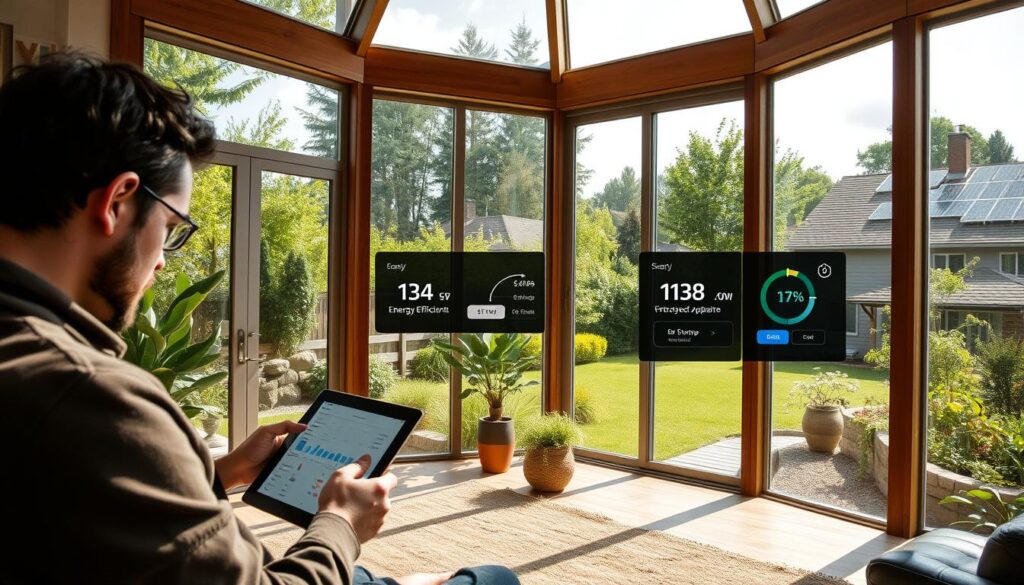
Many people hesitate to adopt smarter practices due to myths and misconceptions. These barriers often prevent homeowners and businesses from making impactful changes. Let’s explore how to address these concerns and unlock the benefits of sustainable solutions.
Debunking Common Misconceptions
One of the biggest myths is that sustainable upgrades are too expensive. In reality, many improvements, like LED lighting or smart thermostats, have low upfront costs and deliver quick savings. For example, a business that upgrades to ENERGY STAR certified appliances can save up to 30% on utility bills.
Another misconception is that these measures aren’t productive. However, studies show that efficient systems enhance production by reducing downtime and improving performance. For instance, a pharmaceutical company saved 156,000 kilowatt-hours annually by optimizing its building systems.
Addressing Initial Investment Concerns
While some upgrades require an initial investment, the long-term savings often outweigh the costs. Programs like rebates and green bank loans make it easier for businesses and homeowners to finance these projects. For example, upgrading to a heat pump water heater can save over $550 annually, with rebates covering up to 30% of the installation cost.
Here are some tips to overcome financial and technical hurdles:
- Start with low-cost upgrades like sealing drafts or switching to LED bulbs.
- Take advantage of federal and local incentives to reduce upfront expenses.
- Work with professionals to identify the most impactful improvements for your activity.
“Investing in smarter systems is not just about savings—it’s about creating a more sustainable future for everyone.”
By addressing these challenges, you can make meaningful changes that benefit both your wallet and the planet. Whether you’re a homeowner or part of a business, the right strategies can help you overcome barriers and achieve long-term success.
Conclusion
Taking steps toward a more sustainable home is easier than you think. By focusing on energy-efficient upgrades, you can reduce your reliance on natural gas and lower your environmental impact. Simple changes, like upgrading appliances or improving insulation, make a big difference.
It’s not just about saving money—it’s about creating a healthier planet. Integrating advanced technologies and renewable sources ensures long-term benefits. Start with an audit to identify areas for improvement and take advantage of available financial incentives.
Every small step counts. By making smarter choices in how you use energy, you’re contributing to a cleaner, greener future. Begin today and see the positive impact of your efforts.
FAQ
What is the difference between energy efficiency and energy conservation?
How can I save money by improving my home’s energy efficiency?
What are some simple ways to reduce greenhouse gas emissions at home?
Are smart thermostats worth the investment?
How do I choose energy-efficient appliances?
What role does insulation play in energy efficiency?
Can renewable energy systems improve efficiency?
What is a home energy audit, and how does it help?
Are there financial incentives for making energy-efficient upgrades?
Is the initial cost of energy-efficient upgrades worth it?
Source Links
- Why Energy Efficiency Matters
- How You Can Make Your Home More Energy- and Water-Efficient
- Understanding energy efficiency
- Energy efficiency: what is it, importance and uses | WTS Energy
- Why Conserve Energy: 8 Benefits of Energy Efficiency
- Energy Efficiency
- 10 Best Innovations for Energy Efficiency in Buildings
- The Most Recent Energy-Saving Technologies and Research
- The Future of Energy Efficiency Trends and Innovations
- 12 Energy Savings Opportunities for your home
- Efficient Home Design
- Fact Sheet | Energy Efficiency Standards for Appliances, Lighting and Equipment (2017) | White Papers
- Energy-Efficient Appliances
- The critical role of power digitalization in innovative building design
- Cooling and Energy Efficiency: A New Era in Building Design
- A Business Case: Leveraging Renewable Energy to Reduce Costs and Enhance Efficiency through Decision enabling tools.
- Renewable Integration
- Reducing Electricity Use and Costs
- How to Conserve Energy: 16 Tips to Save Electricity
- Quick tips to save energy
- Federal Tax Credits for Energy Efficiency
- Energy Efficient Home Improvement Credit
- Busting the top myths about AI and energy efficiency
- Energy Efficiency: Challenges and Solutions
- Conclusions | Energy Efficiency Impact Report
- What Is Energy Efficiency? Here are the Benefits & Examples | Chandra Asri
